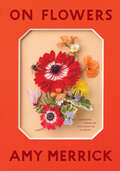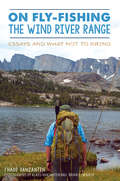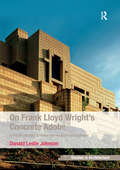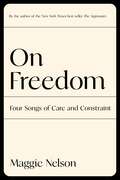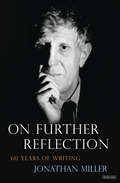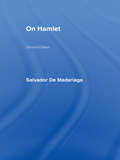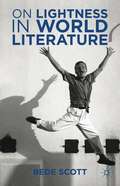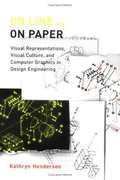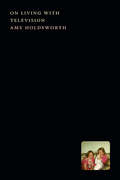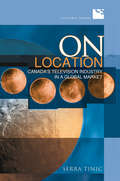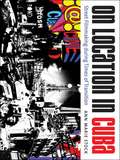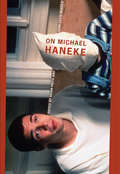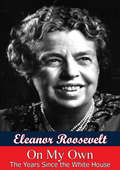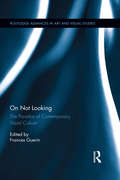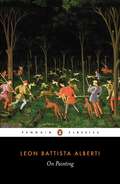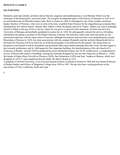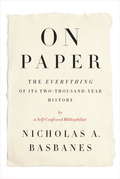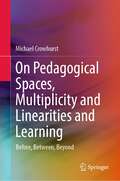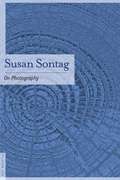- Table View
- List View
On Flowers: Lessons from an Accidental Florist
by Amy MerrickA singular, personal celebration of the beauty and possibilities of nature Amy Merrick is a rare and special kind of artist who uses flowers to help us see the familiar in a completely new way. Her gift is to revel in the unexpected—like a sunny spring arrangement housed in a paper coffee cup—and to overturn preconceptions, whether she’s transforming a bouquet of supermarket carnations into a breathtaking centerpiece or elevating wild and weedy blooms foraged from city sidewalks. She uses the beauty that is waiting to be discovered all around us—in leaves, branches, seedpods, a fallen blossom—to tell a story of time and place. Merrick begins On Flowers with a primer containing all her hard-won secrets on the art of flower arranging, from selecting materials to mastering pleasing proportions. Then she brings readers along on her journey, with observations on flowers in New York City and at her family’s summer home in rural New Hampshire, working on a flower farm off the coast of Washington State, and studying ikebana in a jewel-box flower shop in Kyoto. We learn how to send flowers like a florist, and how to arrange them like a farm girl. We discover the poignancy in humble wildflowers, and also celebrate the luxury of fragrant blousy blooms. Collected here is an anthology of floral inspiration, a love letter to nature by an exceptional, accidental florist.
On Fly-Fishing the Wind River Range: Essays and What Not to Bring (Narrative)
by Chadd VanZanten Klaus VanZanten Brian L. SchieleWith remote waterways and unpressured trout, Wyoming's Wind River Range is the backcountry fly angler's mecca. In the alpine lakes and streams, trout may approach a dry fly two or more at a time, and an angler can cast for days without seeing another person, let alone another angler. But more than just a place to catch lots of fish, the range is also a place to disconnect from noise and networks and reconnect with oneself. In a series of essays on misfortunate father-and-son backpacking trips, disaffected Boy Scouts, psychotropic deep-woods epiphanies and many other topics, author Chadd VanZanten offers not only a survey of the fishing and history of the Wind Rivers but a tour of personal landscapes as well.
On Frank Lloyd Wright's Concrete Adobe: Irving Gill, Rudolph Schindler and the American Southwest (Ashgate Studies in Architecture)
by Donald Leslie JohnsonDuring the years 1919 into 1925 Frank Lloyd Wright worked on four houses and a kindergarten located in metropolitan Los Angeles using concrete blocks as the main building material. The construction system has been described by Wright and others as ’uniquely molded’, ’woven like a textile fabric’ and perceived as ground breaking, truly modern, unprecedented. Many have attempted to uphold these claims while some thought the house-designs borrowed from old exotic buildings. For the first time this book brings together Wright’s declarations, the support of upholders and inferences in order to determine their accuracy and correctness, or the possibility of feigned or fictional stories. It examines technical developments of concrete blocks by Wright and others before his experiences in Los Angeles began in 1919. It also studies the manner of Wright’s design process by an examination of relevant pictorial and textual documents. A unique, in-depth and critical analysis of the houses is set within historical, biographical and theoretical contexts. Consequently, the book explains the impact upon Wright of California contemporaries, architects Irving Gill and Rudolph Schindler, and their instrumentally profound role upon the course of modernism 1907-1923. In doing so, it allows a full appreciation of Wright’s, Gill’s and Schindler’s buildings beyond their experiential qualities.
On Freedom: Four Songs of Care and Constraint
by Maggie NelsonSo often deployed as a jingoistic, even menacing, rallying cry, or limited by a focus on passing moments of liberation, the rhetoric of freedom both rouses and repels. Does it remain key to our autonomy, justice, and well-being, or is freedom's long star turn coming to a close? Does a continued obsession with the term enliven and emancipate, or reflect a deepening nihilism (or both)? On Freedom is an expansive, exhilarating work of criticism that examines such questions by tracing the concept's complexities in four distinct realms: art, sex, drugs, and climate. Drawing on a vast range of material, from critical theory to pop culture to the intimacies and plain exchanges of daily life, Maggie Nelson explores how we might think, experience, or talk about freedom in ways responsive to the conditions of our day. Her abiding interest lies in ongoing "practices of freedom" by which we negotiate our interrelation with--indeed, our inseparability from--others, with all the care and constraint that entails, while accepting difference and conflict as integral to our communion. For Nelson, thinking publicly through the knots in our culture--from recent art-world debates to the turbulent legacies of sexual liberation, from the painful paradoxes of addiction to the lure of despair in the face of the climate crisis--is itself a practice of freedom, a means of forging fortitude, courage, and company. On Freedom is an invigorating, essential book that meets the challenges of our time. Maggie Nelson is the author of several books of poetry and prose, including, most recently, the New York Times best seller and National Book Critics Circle Award winner The Argonauts. She has been the recipient of a MacArthur Fellowship, a Guggenheim Fellowship, an NEA Fellowship, an Innovative Literature Fellowship from the Creative Capital Foundation, and an Arts Writers Grant from the Andy Warhol Foundation. She is currently a professor of English at University of Southern California and lives in Los Angeles. A New York Times Notable Book for 2021.
On Freedom: Four Songs of Care and Constraint
by Maggie NelsonNamed a Most Anticipated/Best Book of the Month by: NPR * USA Today * Time * Washington Post * Vulture * Women’s Wear Daily * Bustle * LitHub * The Millions * Vogue * Nylon * Shondaland * Chicago Review of Books * The Guardian * Los Angeles Times * Kirkus * Publishers WeeklySo often deployed as a jingoistic, even menacing rallying cry, or limited by a focus on passing moments of liberation, the rhetoric of freedom both rouses and repels. Does it remain key to our autonomy, justice, and well-being, or is freedom’s long star turn coming to a close? Does a continued obsession with the term enliven and emancipate, or reflect a deepening nihilism (or both)? On Freedom examines such questions by tracing the concept’s complexities in four distinct realms: art, sex, drugs, and climate.Drawing on a vast range of material, from critical theory to pop culture to the intimacies and plain exchanges of daily life, Maggie Nelson explores how we might think, experience, or talk about freedom in ways responsive to the conditions of our day. Her abiding interest lies in ongoing “practices of freedom” by which we negotiate our interrelation with—indeed, our inseparability from—others, with all the care and constraint that entails, while accepting difference and conflict as integral to our communion.For Nelson, thinking publicly through the knots in our culture—from recent art-world debates to the turbulent legacies of sexual liberation, from the painful paradoxes of addiction to the lure of despair in the face of the climate crisis—is itself a practice of freedom, a means of forging fortitude, courage, and company. On Freedom is an invigorating, essential book for challenging times.
On Further Reflection: 60 Years of Writing
by Jonathan MillerA selection of his best writing from the last six decades and compiled for the first time, On Further Reflection is a showcase of Jonathan Miller's distinguished thoughts on art, science, and many topics in between. Actor, doctor, sculptor, TV personality, director of both film and opera--Sir Jonathan Miller's career covers a vast range of artistic endeavors and intellectual pursuits. Common amongst all of these trades, though, is Miller's exceptional talent for writing about them. Because his work has been published in locations as numerous and diverse as his interests, On Further Reflection is the necessary gathering-together of excerpts from Miller's best and most memorable pieces from the last six decades, and serves as a staggering indicator of the depth and variety of his preoccupations. The collection features his writing on mesmerism and neurology, art history and drama; it contains thoughts on how we interact with our own bodies, and how television changed in the wake of the Kennedy assassination. For each extract he provides a small introduction, placing the writing in the context of his work in the arts and sciences. Miller casts light on many oft-overlooked aspects of the world, and reminds us with his trademark wit and perception that to this day he is a unique presence on the cultural scene. A celebration of one of our finest minds, On Further Reflection brings together the best of Jonathan Miller for the first time in one collection.
On Further Reflection: 60 Years of Writing
by Jonathan MillerA selection of his best writing from the last six decades and compiled for the first time, On Further Reflection is a showcase of Jonathan Miller's distinguished thoughts on art, science, and many topics in between. Actor, doctor, sculptor, TV personality, director of both film and opera—Sir Jonathan Miller's career covers a vast range of artistic endeavors and intellectual pursuits. Common amongst all of these trades, though, is Miller’s exceptional talent for writing about them. Because his work has been published in locations as numerous and diverse as his interests, On Further Reflection is the necessary gathering-together of excerpts from Miller’s best and most memorable pieces from the last six decades, and serves as a staggering indicator of the depth and variety of his preoccupations. The collection features his writing on mesmerism and neurology, art history and drama; it contains thoughts on how we interact with our own bodies, and how television changed in the wake of the Kennedy assassination. For each extract he provides a small introduction, placing the writing in the context of his work in the arts and sciences. Miller casts light on many oft-overlooked aspects of the world, and reminds us with his trademark wit and perception that to this day he is a unique presence on the cultural scene. A celebration of one of our finest minds, On Further Reflection brings together the best of Jonathan Miller for the first time in one collection.
On Hamlet
by Salvador MadariagaPublished in the year 1964, On Hamlet is a valuable contribution to the field of Performance.
On Landscapes (Thinking in Action #29)
by Susan HerringtonThere is no escaping landscape: it's everywhere and part of everyone's life. Landscapes have received much less attention in aesthetics than those arts we can choose to ignore, such as painting or music – but they can tell us a lot about the ethical and aesthetic values of the societies that produce them. Drawing on examples from a wide range of landscapes from around the world and throughout history, Susan Herrington considers the ways landscapes can affect our emotions, our imaginations, and our understanding of the passage of time. On Landscapes reveals the design work involved in even the most naturalistic of landscapes, and the ways in which contemporary landscapes are turning the challenges of the industrial past into opportunities for the future. Inviting us to thoughtfully see and experience the landscapes that we encounter in our daily lives, On Landscapes demonstrates that art is all around us.
On Lightness in World Literature
by Bede ScottDespite the apparent ubiquity of light literature, and despite the greater cultural prestige it has been afforded in recent decades, very little has been written on the adjective that actually defines this category. What, precisely, does it signify, and what are some of the key strategies by which the effect of lightness is achieved within literary discourse? In this original and engaging study, Bede Scott explores the aesthetic quality of lightness as demonstrated by a diverse range of narratives - spanning four different centuries and five different countries. In each case he focuses on a specific 'type' of lightness, whether it be the refined triviality of Sei Shonagon's Pillow Book, the ludic tendencies of Joaquim Maria Machado de Assis' Posthumous Memoirs of Br#65533;s Cubas, or the 'exhilarating and primitive vitality' of Voltaire's Candide. By bringing together such disparate sources, Scott makes a strong case for the universality of this particular aesthetic value, while also subjecting to close critical scrutiny its underlying structural features.
On Line and on Paper: Visual Representations, Visual Culture, and Computer Graphics in Design Engineering
by Kathryn HendersonHenderson offers a new perspective on this topic by exploring the impact of computer graphic systems on the visual culture of engineering design. He shows how designers use drawings both to organize work and knowledge and to recruit and organize resources.
On Literature and Art
by Mao Tse-TungThis historic document brilliantly exemplifies the profound integration of Marxism-Leninism with the practice of the Chinese revolution.
On Living with Television (Console-ing Passions)
by Amy HoldsworthIn On Living with Television, Amy Holdsworth examines the characteristics of intimacy, familiarity, repetition, and duration that have come to exemplify the medium of television. Drawing on feminist television studies, queer theory, and disability studies as well as autobiographical life-writing practices, Holdsworth shows how television shapes everyday activities, from eating and sleeping to driving and homemaking. Recounting her own life with television, she offers a sense of the joys and pleasures Disney videos brought to her disabled sister, traces how bedtime television becomes part of a daily routine between child and caregiver, explores her own relationship to binge-eating and binge-viewing, and considers the idea of home through the BBC family drama Last Tango in Halifax. By foregrounding the ways in which television structures our relationships, daily routines, and sense of time, Holdsworth demonstrates how television emerges as a potent vehicle for writing about life.
On Location
by Serra TinicFilm and television production are important components of the Canadian economy. In Vancouver, popular American television series like The X-Files and Canadian series like Da Vinci's Inquest have boosted the city's profile as a centre for international and domestic productions. Serra Tinic's On Location is the first empirical analysis of regional Canadian television producers in the context of developing global media markets.Tinic observes that global television production in Vancouver has been a contradictory process that has, on one level, led to the homogenization of culturally specific storylines, while simultaneously facilitating the development of new avenues for international ventures. The author explains how federal and regional network considerations, funding guidelines, and partnerships with international co-producers affect the capacity of Canadian television producers to negotiate culturally specific storylines in the development process. She further interrogates the concepts of globalization, culture, and national identity, and their relationship to broadcasting from the perspectives of members of the television industry themselves, highlighting the extent to which industry practices in Vancouver epitomize current trends in global television production. On Location fills a major gap in contemporary media and cultural studies debates that question the connections between the politics of place, culture, and commerce within the larger context of cultural globalization.
On Location in Cuba: Street Filmmaking During Times of Transition
by Ann Marie StockThe 1990s were a time of dramatic transformation for Cuba. With the collapse of its Cold War relationship with the Soviet Union, the island nation plummeted into an era of scarcity and uncertainty known as the Special Period, a time from which it emerged only slowly in the new century. On Location in Cubaviews these pivotal decades through the lens of cinema. Ann Marie Stock conducted hundreds of interviews and conversations in Cuba to examine individual artists' lives and creative output--including film, video, and audiovisual art. She explores the impact of the Cold War's end, the economic crisis that ensued, and the decentralization of the state's political, economic, and cultural apparatus. Stock focuses on what she calls Street Filmmaking--the production of emerging audiovisual artists who work outside the state film industry--to examine the island's transformation and changing notions of Cuban identity. Employing entrepreneurial approaches to producing art and to negotiating the exigencies of globalization, this younger generation of filmmakers offers fresh perspectives on what it means to be Cuban in an increasingly complex and connected world.
On Media, On Technology, On Life - Interviews with Innovators
by Arthur Clay, Timothy J. SeniorThe book 'On Media, On Technology, On Life: Interviews with Innovators' features thirteen artist-researchers whose artworks reconfigure the relationships between living bodies, microorganisms, tools, techniques, and institutions to ask new questions of life itself. When encountered for the first time, these are works that seem to challenge a conventional understanding of what artists and scientists do. Through the words of the artists themselves, these interviews explore what it means to spearhead innovative new partnerships able to create work that takes on a life of its own. By posing new questions at the interface between media, technology, and life, the book explores themes such as the life of multi-species bodies, the future of food security in the age of biotechnology, the microbial lives of historic archives, and the biohacker communities of the future. Together, they reveal how we are all actors in this theatre of life innovation.
On Michael Haneke
by Brian Price John David RhodesConsiders the films of Michael Haneke, who has emerged as a major figure in world cinema over the last fifteen years.
On My Knees: Stark International 2 (Stark International Series #2)
by J. KennerNew York Times bestselling author J. Kenner continues her smoking hot, emotionally compelling new erotic Stark International trilogy, which began with Say My Name, returning to the world of her beloved Stark novels, Release Me, Claim Me and Complete Me, with the explosive romance between Jackson Steele and Sylvia Brooks. For fans of Fifty Shades of Grey, Sylvia Day, Meredith Wild and Jodi Ellen Malpas.I never thought I'd lose control, but his desire took me to the edge. Powerful, ambitious and devastatingly sexy, Jackson Steele was unlike any other man I'd ever known. He went after what he wanted with his whole mind, body and soul - and I was the woman in his sights. One touch and I surrendered, one night together and I was undone. Jackson and I had secrets, dark pieces of our pasts that threatened to swallow us both. I was scared to trust him fully, to finally let go. Yet no matter the dangers that lay ahead, I knew I was his - that there could be no more holding back and that in our passion lay our salvation...Return to the smoking hot Stark world with the Stark International trilogy: Say My Name, On My Knees and Under My Skin is the explosively emotional story of Jackson Steele and Sylvia Brooks.Fall in love with J. Kenner's hot and addictive bestselling Stark series charting the romance of Nikki and Damien Stark: Release Me, Claim Me, Complete Me, Take Me, Have Me, Play My Game, Seduce Me and Unwrap Me.Don't miss J. Kenner's explosive Most Wanted series of three enigmatic and powerful men, and the striking women who can bring them to their knees: Wanted, Heated and Ignited.
On My Own: The Years Since The White House
by Eleanor RooseveltIn this volume the greatest and best-loved woman of her time shares the experiences - private and public - of her thirteen years since the death of her husband, Franklin Delano Roosevelt. She describes in intimate detail the problems she had to solve after her husband's death, winding up his affairs and working out a pattern for her new life. That new life would include much traveling and diplomatic work around Europe, Russia and Asia for the United Nations, for her forthright humanitarian endeavors she was voted as ninth in Gallup's List Of Most Widely Admired People Of The 20th Century.
On Not Looking: The Paradox of Contemporary Visual Culture (Routledge Advances in Art and Visual Studies)
by Frances GuerinOn Not Looking: The Paradox of Contemporary Visual Culture focuses on the image, and our relationship to it, as a site of "not looking." The collection demonstrates that even though we live in an image-saturated culture, many images do not look at what they claim, viewers often do not look at the images, and in other cases, we are encouraged by the context of exhibition not to look at images. Contributors discuss an array of images—photographs, films, videos, press images, digital images, paintings, sculptures, and drawings—from everyday life, museums and galleries, and institutional contexts such as the press and political arena. The themes discussed include: politics of institutional exhibition and perception of images; censored, repressed, and banned images; transformations to practices of not looking as a result of new media interventions; images in history and memory; not looking at images of bodies and cultures on the margins; responses to images of trauma; and embodied vision.
On Painting
by Leon AlbertiArtist, architect, poet and philosopher, Leon Battista Alberti revolutionized the history of art with his theories of perspective in On Painting (1435). Inspired by the order and beauty inherent in nature, his groundbreaking work sets out the principles of distance, dimension and proportion; instructs the painter on how to use the rules of composition, representation, light and colour to create work that is graceful and pleasing to the eye; and stipulates the moral and artistic pre-requisites of the successful painter. On Painting had an immediate and profound influence on Italian Renaissance artists including Ghiberti, Fra Angelico and Veneziano and on later figures such as Leonardo da Vinci, and remains a compelling theory of art.
On Painting
by Leon Battista Alberti Martin KempArtist, architect, poet and philosopher, Leon Battista Alberti revolutionized the history of art with his theories of perspective in On Painting (1435). Inspired by the order and beauty inherent in nature, his groundbreaking work sets out the principles of distance, dimension and proportion; instructs the painter on how to use the rules of composition, representation, light and colour to create work that is graceful and pleasing to the eye; and stipulates the moral and artistic pre-requisites of the successful painter. On Painting had an immediate and profound influence on Italian Renaissance artists including Ghiberti, Fra Angelico and Veneziano and on later figures such as Leonardo da Vinci, and remains a compelling theory of art. <p><p>For more than seventy years, Penguin has been the leading publisher of classic literature in the English-speaking world. With more than 1,700 titles, Penguin Classics represents a global bookshelf of the best works throughout history and across genres and disciplines. Readers trust the series to provide authoritative texts enhanced by introductions and notes by distinguished scholars and contemporary authors, as well as up-to-date translations by award-winning translators.
On Paper: The Everything of Its Two-Thousand-Year History
by Nicholas A. BasbanesA consideration of all things paper--its invention that revolutionized human civilization; its thousand-fold uses (and misuses), proliferation, and sweeping influence on society; its makers, shapers, collectors, and pulpers--written by the admired cultural historian and author of the trilogy on all things book-related: A Gentle Madness; Patience and Fortitude ("How could any intelligent, literate person not just love this book?"--Simon Winchester); and A Splendor of Letters ("Elegant, wry, and humane"--André Bernard, New York Observer). Nicholas Basbanes writes about paper, from its invention in China two thousand years ago to its ideal means, recording the thoughts of Islamic scholars and mathematicians that made the Middle East a center of intellectual energy; from Europe, by way of Spain in the twelfth century and Italy in the thirteenth at the time of the Renaissance, to North America and the rest of the inhabited world. Basbanes writes about the ways in which paper has been used to record history, make laws, conduct business, and establish identities . . . He makes clear that without paper, modern hygienic practice would be unimaginable; that as currency, people will do almost anything to possess it . . . that the Industrial Revolution would never have happened without paper on which to draw designs and blueprints. We see paper's crucial role in the unfolding of historical events, political scandals, and sensational trials: how the American Revolution which took shape with the Battle of Lexington and Concord, began with the Stamp Act of 1765 . . . the Dreyfus Affair and the forged memorandum known as "the bordereau" . . . America's entry into World War I with the Zimmerman Telegram . . . the Alger Hiss spy case and Whittaker Chambers's testimony involving the notorious Pumpkin Papers . . . Daniel Ellsberg's release of the Pentagon Papers in 1971 and the scandal of Watergate. Basbanes writes of his travels to get to the source of the story--to China, along the Burma Road, and to Japan, whose handmade paper, washi, is as much an expression of the human spirit as it is of craftsmanship . . . to Landover, Maryland, home of the National Security Agency and its one hundred million ultra secret documents, pulped by cryptologists and sent to be recycled as pizza boxes and egg cartons . . . to the Crane Paper mill of Dalton, Massachusetts, a seventh-generation family-owned enterprise, the exclusive supplier of paper for American currency since 1879 . . . and to the Kimberly-Clark mill in New Milford, Connecticut, manufacturer daily of one million boxes of Kleenex tissue and as many rolls of Scott kitchen towels.Entertaining, illuminating, irresistible, a book that masterfully guides us through paper's inseparability from human culture . . .
On Pedagogical Spaces, Multiplicity and Linearities and Learning: Before, Between, Beyond
by Michael CrowhurstThis book introduces a research method called ‘auto-teach(er)/ing-focused research,’ a research process that aims to document understandings generated by, and for the teacher when that teacher teaches or re-teaches a course. It demonstrates how this method is applied by the author/researcher within the pedagogical space that is the teaching of a course, one that has been taught numerous times by the author/researcher over many years. This book documents understandings about learning and teaching that have emerged within the pedagogical space that is the teaching of a course, and the pedagogical space that is the writing of a book. It explores the notion that pedagogical spaces are complex, and that subjects navigate and are produced within them in a multiplicity of ways. This book applies a research method that generates a knowledge product that research practitioners in a variety of settings might find useful to adopt or adapt.
On Photography
by Susan Sontag6 essays on photography (In Plato's Cave; America, Seen Through Photographs, Darkly; Melancholy Objects; The Heroism of Vision; Photographic Evangels; The Image-World), and a brief anthology of quotations.
